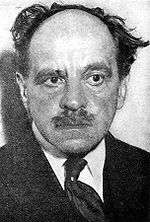Jakob Wassermann
| Jakob Wassermann | |
|---|---|
|
Jakob Wassermann, before 1934 | |
| Born |
March 10, 1873 Fürth, German Empire |
| Died |
January 1, 1934 (aged 60) Altaussee, Austria |
| Nationality | German |
| Religion | Jewish |
Jakob Wassermann (Hebrew: יעקב וסרמן; March 10, 1873 – January 1, 1934) was a German writer and novelist of Jewish descent.
Life
Born in Fürth, Wassermann was the son of a shopkeeper and lost his mother at an early age. He showed literary interest early and published various pieces in small newspapers. Because his father was reluctant to support his literary ambitions, he began a short-lived apprenticeship with a businessman in Vienna after graduation.
He completed his military service in Würzburg. Afterward, he stayed in southern Germany and in Zurich. In 1894 he moved to Munich. Here he worked as a secretary and later as a copy editor at the paper Simplicissimus. Around this time he also became acquainted with other writers Rainer Maria Rilke, Hugo von Hofmannsthal, and Thomas Mann.
In 1896 he released his first novel, Melusine. Interestingly, his last name (Wassermann) means "water-man" in German; a "Melusine" (or "Melusina") is a figure of European legends and folklore, a feminine spirit of fresh waters in sacred springs and rivers.
From 1898 he was a theater critic in Vienna. In 1901 he married Julie Speyer, whom he divorced in 1915. Three years later he was married again to Marta Karlweis.
After 1906, he lived alternatively in Vienna or at Altaussee in der Steiermark where he died in 1934 after a severe illness.
In 1926, he was elected to the Prussian Academy of Arts. He resigned in 1933, narrowly avoiding an expulsion by the Nazis. In the same year, his books were banned in Germany owing to his Jewish ancestry.
Wassermann's work includes poetry, essays, novels, and short stories. His most important works are considered the novel Der Fall Maurizius (1928) and the autobiography, My Life as German and Jew (Mein Weg als Deutscher und Jude) (1921), in which he discussed the tense relationship between his German and Jewish identities.[1]
Works

drawing by Emil Orlik
- Melusine (Novel, 1896)
- Die Juden von Zirndorf (English title: The Dark Pilgrimage) (Novel, 1897)
- Schläfst du, Mutter? (Novella, 1897)
- Die Geschichte der jungen Renate Fuchs (Novel, 1900)
- Der Moloch (Novel, 1902)
- Der niegeküsste Mund (Stories, 1903)
- Die Kunst der Erzählung (Essay, 1904)
- Alexander von Babylon (Novel, 1905)
- Donna Johanna von Castilien (Narrative, 1906)
- Die Schwestern (Novellas - Donna Johanna von Castilien, Sara Malcolm, Clarissa Mirabel - 1906)
- Caspar Hauser oder Die Trägheit des Herzens (Novel, 1908)
- Die Gefangenen auf der Plassenburg (Narrative, 1909)
- Die Masken des Erwin Reiners (1910)
- Der goldene Spiegel (Novella, 1911)
- Geronimo de Aguilar (Story, 1911)
- Faustina (Narrative, 1912)
- Der Mann von vierzig Jahren (Novel, 1913)
- Das Gänsemännchen (Novel, 1915)
- Christian Wahnschaffe (Novel, 1919) (English translation under the title: The world's illusion)
- Die Prinzessin Girnara, Weltspiel und Legende (Play, 1919)
- Mein Weg als Deutscher und Jude (Autobiography, 1921)
- Imaginäre Brücken (Studies and Essays, 1921)
- Sturreganz (Narrative, 1922)
- Ulrike Woytich (Novel, 1923)
- Faber, oder die verlorenen Jahre (Novel, 1924)
- Laudin und die Seinen (Novel, 1925)
- Das Amulett (Novella, 1926)
- Der Aufruhr um den Junker Ernst (Novella, 1926)
- Das Gold von Caxamalca (Stories, 1928)
- Christoph Columbus (Biography, 1929
- Selbstbetrachtungen) (Reflections, 1931)
- Novel trilogy:
- Der Fall Maurizius (The Maurizius Case) (1928)
- Etzel Andergast (1931)
- Joseph Kerkhovens dritte Existenz (1934)
Notes
- ↑ Scharfstein S: Jewish History and You. Jersey City, New Jersey: Ktav Publishing House, page 123. Accessed 2008-12-18. ISBN 0-88125-806-7.
References
- John Carl Blankenagel: The writings of Jakob Wassermann. Boston, The Christopher publishing house, 1942.
- Henry Miller: Reflections on The Maurizius case: a humble appraisal of a great book. Santa Barbara, Calif.: Capra Press, 1974.
- Alice Cohn Hanberg: The humanism of Jakob Wassermann. Thesis-University of California. Microfilm. Los Angeles, University of California, Library Photographic Service, 1953.
- Stephen H. Garrin: The concept of justice in Jakob Wassermann’s trilogy. Bern: Lang, 1979.
External links
- Works by Jakob Wassermann at Project Gutenberg
- Works by or about Jakob Wassermann at Internet Archive
- Works by Jakob Wassermann at LibriVox (public domain audiobooks)

- Guide to the Jakob Wassermann Autographs Collection at the Leo Baeck Institute, New York.
